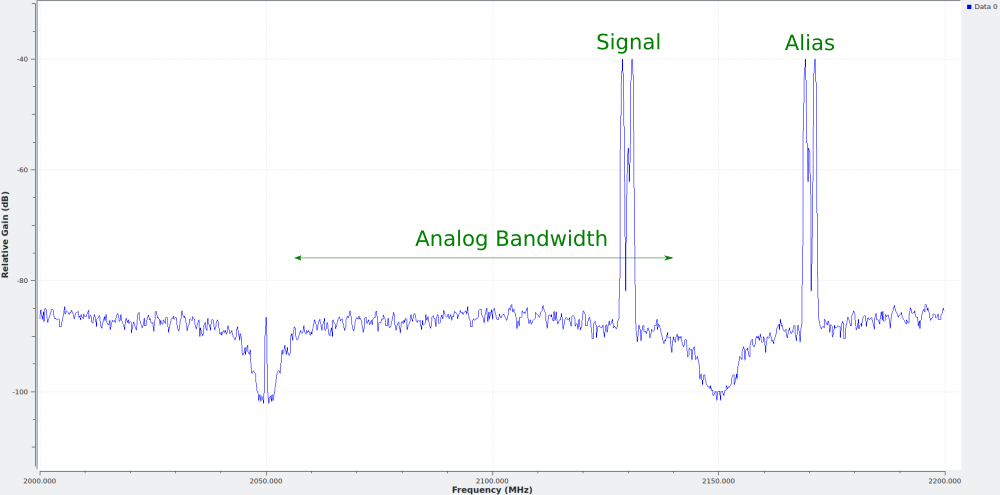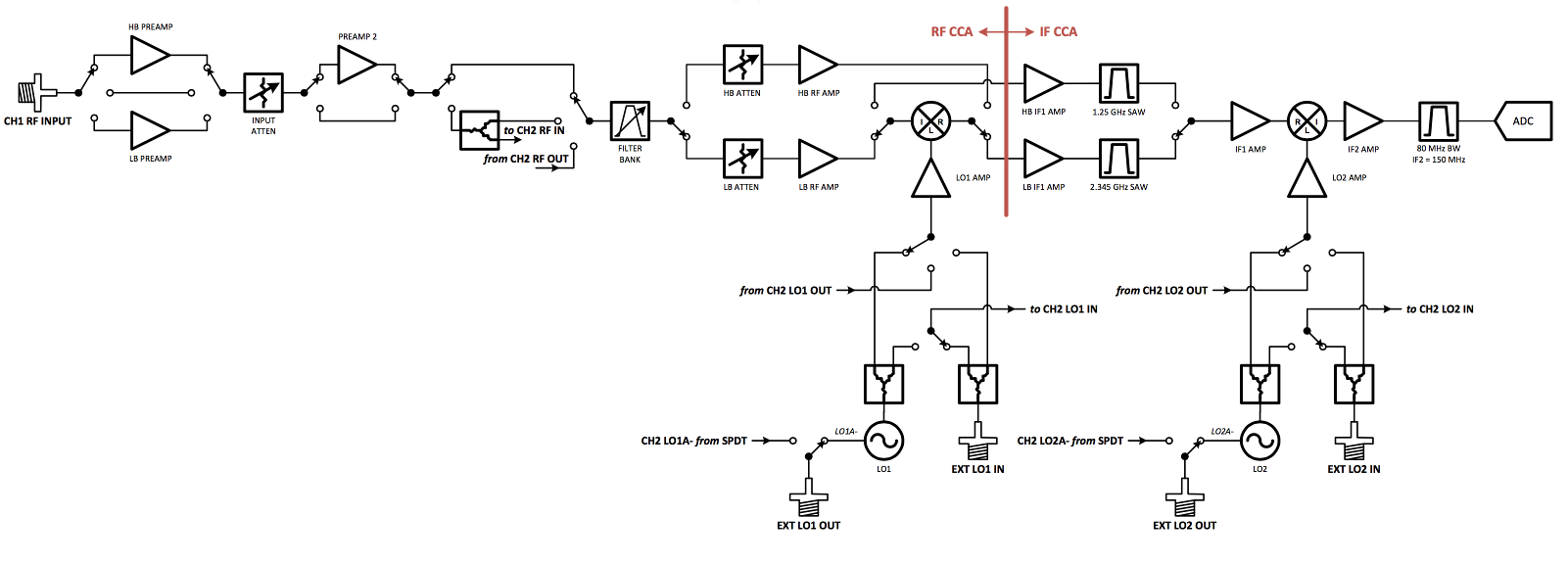The TwinRX is a two-channel superheterodyne receiver designed for high performance spectrum monitoring and direction finding applications. The receiver is tunable from 10 MHz - 6 GHz and has 80 MHz of instantaneous bandwidth per channel, providing the versatility necessary to analyze a variety of signals in multiple bands of interest. Each channel has an independent RF signal chain with preamplifiers, preselectors, and two mixer stages for superior selectivity. Users can tune the two channels independently to simultaneously monitor uplink and downlink communication with a combined bandwidth of 160 MHz. The ability to share the LO between channels across multiple daughterboards enables the phase-aligned operation required to implement scalable multi-channel phased-arrays. The receiver is capable of fast frequency hopping to detect frequency agile emitters.
The TwinRX daughterboard only works with the X300/X310 series of USRPs.
Due to the specific configuration of the analog filters, the TwinRX only supports a master clock rate of 200 MHz. Since the X300/X310 only has a single master clock, this means that the only valid tick rate for the X300/X310 is 200 MHz, even if there is another daughterboard in the same device which could support a different tick rate.
The maximum supported sample rate is 200 Msps if using one channel and 100 Msps if using both channels. TwinRX only supports instantaneous bandwidth up to 80 MHz, so a sample rate of 100 Msps or less is sufficient for all applications. Decimation from the 200 Msps tick rate to the desired sample rate is handled automatically when using the default FPGA images either by setting the sample rate (if using the multi_usrp API) or by setting the output rate of the DDC (if using the RFNoC API).
IMPORTANT NOTE: If building a custom RFNoC image and using both channels of the TwinRX, the 400 Msps produced by the Radio block (2 channels at 200 Msps each) exceeds the 200 Msps throughput capacity of the crossbar in the RFNoC framework. To resolve this, a block that consumes the 400 Msps and produces less than 200 Msps must be statically connected to the Radio block. The default X300 and X310 FPGA images have a DDC block statically connected to the Radio block which handles the decimation automatically by setting the output rate on each channel of the DDC to 100 Msps or less. It is recommended to leave the DDC statically connected to the Radio for custom RFNoC FPGA images, but the DDC can be replaced by a custom block as long as it consumes the 400 Msps and produces an aggregate of less than 200 Msps.
Starting with UHD release 4.1, the X310/X300 FPGA images no longer contain a halfband anti-aliasing filter directly after the ADC when using TwinRX. The filter was left out because the radio no longer decimates the sampling rate for TwinRX, instead relying on the DDC RFNoC block to adjust the sampling rate, and the DSP utilization of the filter was permanent, even when no TwinRX daughtercard was used. This means the output of the radio block (which produces a 200 Msps output signal when using TwinRX) contains aliases of the signal. The following image shows the output of the X310+TwinRX when configuring it to run at 200 Msps. The center frequency is set to 2.1 GHz, and a signal is applied at approx. 2.13 GHz.

Due to aliasing, a mirrored alias signal will also appear at 2.17 GHz. The statically connected DDC block will remove these aliases.

The receive filter banks uses switches to select between the available filters. These paths are also dependent on the antenna switch settings. Incorrectly setting the switches generally results in attenuated input / output power. Receive filters are band pass (series high & low pass filters).
Source code related to controlling the filter band and antenna switches resides in twinrx_experts.cpp. Specifically, refer to the twinrx::twinrx_freq_path_expert class. Generally, these methods set the switches depending on the state of the receive streams.
The following sections provide switch setting tables for antenna and filter selection for frontend's receive paths. For further details refer to the schematics.
| Band | Range |
|---|---|
| LB1 | 10 - 500 MHz |
| LB2 | 500 - 800 MHz |
| LB3 | 800 - 1.2 GHz |
| LB4 | 1.2 - 1.8 GHz |
| HB1 | 1.8 - 3.0 GHz |
| HB2 | 3.0 - 4.1 GHz |
| HB3 | 4.1 - 5.1 GHz |
| HB4 | 5.1 - 6.0 GHz |
The TwinRX has the ability to export the two Local Oscillator (LO) signals from one channel to the companion channel on the same daughterboard and/or to one or more other TwinRXs in order to form a phase-synchronous multi-channel receiver.
| Connector | Description | Min | Nominal | Damage |
|---|---|---|---|---|
| J1 | LO2 Export | 0 dBm | 3 dBm | NA (Output) |
| J2 | LO2 Input | 0 dBm | 2 dBm | 20 dBm |
| J3 | LO1 Export | -12 dBm | 5 dBm | NA (Output) |
| J4 | LO1 Input | -10 dBm | -5 dBm | 10 dBm |
The TwinRX has two external antenna connectors (RX1 and RX2) which can be switched internally to either receiver channel. By default RX1 is connected to the first channel and RX2 to the second.
When routing the antennas in any configuration other than the default there are some behavioral changes to be aware of. As can be seen in the block diagram above the signal path from each antenna can be switched into a resistive divider and then to either or both of the receive channels. If the divider is in use the incoming signal will be slightly attenuated when compared to the direct passthrough. If both receive channels are configured to use the same antenna the first two amplifiers and are a variable attenuator are shared. The effect of this is that the first channel's gain settings for those amplifiers will override the second channel's. If both channels are tuned to the same frequency band and at similar gain settings the effect will be minimal, but if the frequency or gain difference is large the resulting gain on the second channel could be significantly lower or higher than expected. Additionally the signal path length will increase in comparison to the direct antenna mapping so the phase of the received signal will be different depending on the antenna mapping.
The X300/X310 motherboards support power-calibrating the daughterboards, and therefore TwinRX can also make use of this calibration API (see also Power Level Controls).
However, unlike other daughterboards, the relationship between actual, received power, and power measured at the ADC depend on more parameters than with the other daughterboards. First of all, the TwinRX has two complete analog receiver chains, unlike all the other daughterboards. Both receiver chains can be connected to any RF input, which already increases the number of combinations that need to be calibrated. Furthermore, the RF paths inside the daughterboard have an optional switch, which allows both receivers to receive from the same input, at different frequencies.
single chan
x3xx_power_cal_rx_rx1 + serial:{0, 1} x3xx_power_cal_rx_rx2 + serial:{0, 1}
dual chan
x3xx_power_cal_rx_rx1 + serial:{00, 11} x3xx_power_cal_rx_rx2 + serial:{00, 11}